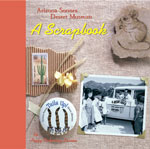
Extended Entries to the ASDM Scrapbook
Wildlife Photographic Blind
Lew Walker was a fine wildlife photographer and author, contributing to National Geographic Magazine, Natural History Magazine, Nature, and other major publications, when he came to work at the Desert Museum. With his discovery of animal tracks around a leaking water pipe near the Mountain House stables, he immediately saw photographic possibilities. "We added 40 feet of pipe to the leaking joint. This carried the water to a small pool under the arm of a grotesque saguaro. The pool lay at the bottom of a shallow boulder-strewn ravine," he wrote in "Arizona's Window on Wildlife," for National Geographic.
Just a few feet from the waterhole Walker built a narrow blind, which stair-stepped up the side of the ravine on four levels. A window at each level and four swivel chairs inside the blind accommodated up to four photographers and provided for different angle shots. Small openings in each window allowed the photographers a clear view of activities at the water hole. The floor and walls of the blind were covered with heavy carpeting to ensure quiet. There was a central control system so that each photographer's camera shot at the same time in conjunction with setting off the flashes. Flash bulbs could be changed from inside the blind though the reflectors were on the exterior of the blind. Outside a dim, 15-watt spotlight allowed the photographers to observe happenings at the water hole. The animals soon became accustomed to this light and were not bothered by it.
Animals primarily came for water at the pool, but meat and blocks of salt were also placed near the water. The ideal months for photographing at the blind were during the desert's direst periods: April, May, June, October, November, and early December.
Much to Lew's amazement, when the waterhole was first established the animals did not immediately discover it. "We watched incredulously as whole herds passed within 15 feet of the new water hole without detecting it. Going to the old site, they would stand bewildered, tongues hanging out. . . happily, one deer finally blundered upon the pool and led the others to it."